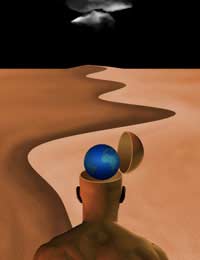Surrealist

Surrealism is a style developed in the early 20th Century and highly influenced by philosophical and psychological currents of the time. The Surrealist Movement was an organised network of artists dedicated primarily to exploring the effects of the unconscious mind on artwork. This primarily entailed focusing upon the roles of dream fantasy and chance experience as a means of evoking images that were then painted, drawn, photographed and filmed.
Drawing on knowledge of psychoanalysis, word games were often played by the surrealist in which it was hoped interesting hidden association were thrown up. Humour was also employed by juxtaposing unrelated objects within works (such as a lobster and a telephone) and by making use of the ‘non-sequitur’. The non-sequitur is a response given in conversation that has no relation to the phrase that preceded it, as in:
- Person One: ‘I am going to the shops, would you like to come?’
- Person Two responds: ‘A pink Elephant wearing fishnet stockings.’
Prominent Surrealists included Salvador Dali ( 1904 – 1989 a household name who has a huge influence on artists our generation), Man Ray ( 1890 – 1976, who’s experiments with photography have been groundbreaking and Andre Breton (1896 – 1966), famed for the iron grip that he ruled over the Surrealist movement with. The surrealists were famed for behaviour as bizarre as the artworks they produced as the movement favoured eccentrics. The surrealist style is certainly one for the poets and natural creatives among us.
Surrealist Exercise
The Exquisite Corpse game is one that you may be familiar with. It is little known that it was initially a game played by Surrealist artists to free up their unconscious creativity. To try this exercise you need a sheet of a4 paper, two pens or pencils and two artists.Divide the paper by folding into 5 sections and fold on top of itself so that only one section is visible initially. Each artist takes it in turn to draw a section of a human body from the head to the toes, yet each time the paper must be folded so as to avoid seeing the progress of the drawing so far. The result of the drawing will inevitably be surprising, often appearing to be bold and humorous despite its poor proportions.
Another exercise involves keeping a visual dream diary whereby you leave a sketch book by your bed and draw the impressions you remember from your dreams upon waking. This can provide a valuable source of inspiration, and after a while you will start to see a variety of recurring visual motifs in your dreams that can become a rich source of subject matter for the artist.


Re: Contextualising Your Work
Dear Mr Watson, I have been working relentlessly for 40 years through Art, writing, performance based expressions in theatre, dance,…
Re: How to Sell My Paintings and Drawings?
Hi , I would like say about my cousin that he live in Afghanistan and he is fabulous in art painting and doing job…
Re: How to Sell My Paintings and Drawings?
Amy - Your Question:Hi I have just left school and I love to draw I do pencil work and I would love to sell my…
Re: How to Sell My Paintings and Drawings?
Hi I have just left school and I love to draw I do pencil work and I would love to sell my drawing but I don't no how…
Re: How to Sell My Paintings and Drawings?
Hi, I have 3 drawings the information as follows: 1- Salvador Dali (Spanish Draftsman). Is 24x19 cm. 2- Pablo…
Re: Freeing Yourself Up
I love drawing so much and I will like to be one of the best artist in the world
Re: How to Sell My Paintings and Drawings?
anna-81 - Your Question:Hi, I need help how can I sale my paintings and drawings and I want to know if my work is…
Re: How to Sell My Paintings and Drawings?
Hi, i need help how can i sale my paintings and drawings and i want to know if my work is really good or not. I'm…
Re: How to Sell My Paintings and Drawings?
i want to sell my drawing give me the idea.
Re: How to Sell My Paintings and Drawings?
I am 15 years old and i would like to sell my pencil drawing